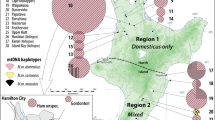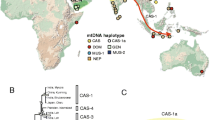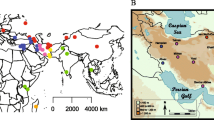Abstract
Biological invasions and climate change are two of the largest threats to biodiversity, and this is especially true for island ecosystems that have largely evolved in isolation. The house mouse is considered to have been introduced to sub-Antarctic Marion Island by sealers in the early 1800s. It is currently widespread across the island and has a large impact on the indigenous biota. To date, little information is available on genetic aspects of biological invasions in the sub-Antarctic. Ten specimens of the house mouse were collected from two geographically separated localities on Marion Island. Sequences of the mitochondrial DNA control region revealed only two haplotypes, separated by a single site change. More importantly, these haplotypes are shared between the eastern and western side of Marion Island. By comparing our sequences to data available on GenBank, we provide evidence that house mice on Marion Island is Mus musculus domesticus (Rutty 1772), and most closely related to haplotypes characterizing this species from Denmark, Sweden, Finland, and northern Germany.

Similar content being viewed by others
References
Akimoto M, Niikura M, Ichikawa M, Yonekawa H, Nakada K, Honma Y, Hayashi J (2005) Nuclear DNA but not mtDNA controls tumor phenotypes in mouse cells. Biochem Biophys Res Commun 327:1028–1035
Alpers DA, Jansen van Vuuren B, Arctander P, Robinson TJ (2004) Population genetics of the roan antelope (Hippotragus equinus) with suggestions for conservation. Mol Ecol 13:1771–1784
Avenant NL, Smith VR (2003) The microenvironment of house mice on Marion Island (sub-Antarctic). Polar Biol 26:129–141
Berry RJ, Peters J, Van Aarde RJ (1978) Sub-antarctic house mice, colonization, survival and selection. J Zool (Lond) 184:127–141
Bester MN, Bloomer JP, Bartlett PA, Muller DD, van Rooyen M, Büchner H (2000) Final eradication of feral cats from sub-Antarctic Marion Island, southern Indian Ocean. S Afr J Wildl Res 30:53–57
Capanna E, Gropp A, Winking H, Noack G, Civitelli MV (1976) Robertsonian metacentrics in the mouse. Chromosoma 58:341–353
Chown SL, Cooper J (1995) Report on a workshop held at the University of Pretoria 16–17 February 1995. Directorate: Antarctica and Islands Department of Environmental Affairs and Tourism
Chown SL, Smith VR (1993) Climate change and the short-term impact of feral house mice at the sub-Antarctic Prince Edward Islands. Oecologia 96:508–516
Chown SL, Rodrigues AS, Gremmen NJM, Gaston KJ (2001) World Heritage status and the conservation of Southern Ocean islands. Conserv Biol 15:550–557
Chown SL, McGeoch MA, Marshall DJ (2002) Diversity and conservation of invertebrates on the sub-Antarctic Prince Edward Islands. Afr Entomol 10:67–82
Cooper J, Condy PR (1988) Environmental conservation at the sub-Antarctic Prince Edward Islands: a review and recommendations. Environ Conserv 15:317–326
Crafford JE, Scholtz CH (1987) Quantitative differences between the insect faunas of sub-Antarctic Marion and Prince Edward Islands: a result of human intervention? Biol Conserv 40:255–262
Cuthbert R, Hilton G (2004) Introduced House Mice Mus musculus: a significant predator of endangered and endemic birds on Gough Island, South Atlantic Ocean? Biol Conserv 117:483–489
Duplantier JM, Orth A, Catalan J, Bonhomme F (2002) Evidence for a mitochondrial lineage originating from the Arabian peninsula in the Madagascar house mouse (Mus musculus). Heredity 89:154–158
Frenot Y, Chown SL, Whinam J, Selkirk PM, Convey P, Skotnicki M, Bergstrom DM (2005) Biological invasions in the Antarctic: extent, impacts and implications. Biol Rev 80:45–72
Gündüz I, Tez C, Malikov V, Vaziri A, Polyakov AV, Searle JB (2000) Mitochondrial DNA and chromosomal studies of wild mice (Mus) from Turkey and Iran. Heredity 84:458–467
Gündüz I, Auffray JC, Britton-Davidian J, Catalan J, Ganem G, Ramalhinho MG, Mathias ML, Searle JB (2001) Molecular studies on the colonization of the Madeiran archipelago by house mice. Mol Ecol 10:2023–2029
Gündüz I, Rambau RV, Tez C, Searle JB (2005) Mitochondrial DNA variation in the western house mouse (Mus musculus domesticus) close to its site of origin: studies in Turkey. Biol J Linn Soc Lond 84:473–485
Hall KJ (1990) Quaternary glaciations in the Southern Ocean: sector 0° long–180° long. Quaternary Sci Rev 9:217–228
Hall KJ (2002) Review of present and Quaternary peri-glacial processes and landforms of the maritime and sub-Antarctic region. S Afr J Sci 98:71–81
Hänel C, Chown SL (1999) An introductory guide to the Marion and Prince Edward Island Special Nature Reserves. Fifty years after annexation. Department of Environmental Affairs and Tourism, Pretoria
Hillis DM, Moritz C, Mable BK (1996) Molecular systematics, 2nd edn. Sinauer Associates Inc., Sunderland, MA
Huyser O, Ryan PG, Cooper J (2000) Changes in population size, habitat use and breeding biology of lesser sheathbills (Chionis minor) at Marion Island: impacts of cats, mice and climate change? Biol Conserv 92:299–310
Ihle S, Ravaoarimanana I, Thomas M, Tautz D (2006) An analysis of signatures of selective sweeps in natural populations of the house mouse. Mol Biol Evol 23:790–797
Jones AG, Chown SL, Gaston KJ (2003) Introduced house mice as a conservation concern on Gough Island. Biodivers Conserv 12:2107–2119
Le Roux V, Chapuis J-L, Frenot Y, Vernon P (2002) Diet of the house mouse (Mus musculus) on Guillou Island, Kergeulen archipelago, Subantarctic. Polar Biol 25:49–57
Lundrigan BL, Jansa SA, Tucker PK (2002) Phylogenetic relationships in the genus Mus, based on paternally, maternally, and biparentally inherited characters. Syst Biol 51:410–431
Maniatis T, Fritsch EF, Sambrook J (1982) Molecular cloning. Cold Spring Harbor Publications, Cold Spring Harbor, New York
Nowak RM (1999) Walker’s mammals of the world, 6th edn. John Hopkins University Press, Baltimore
Orth A, Auffray JC, Bonhomme F (2002) Two deeply divergent mitochondrial clades in the wild mouse Mus macedonicus reveal multiple glacial refuges south of Caucasus. Heredity 89:353–357
Piálek J, Hauffe HC, Searle JB (2005) Chromosomal variation in the house mouse. Biol J Linn Soc 84:535–563
Prager EM, Tichy H, Sage RD (1996) Mitochondrial DNA sequence variation in the eastern house mouse, Mus musculus: comparison with other house mice and report of a 75-bp tandem repeat. Genetics 143:427–446
Prager EM, Orrego C, Sage RD (1998) Genetic variation and phylogeography of central Asian and other house mice, including a major new mitochondrial lineage in Yemen. Genetics 150:835–861
Robinson TJ (1978) Preliminary report of a Robertsonian translocation in an isolated feral Mus musculus population. Mamm Chromosomes Newsl 19:84–85
Smith VR (2002) Climate change in the sub-Antarctic: an illustration from Marion Island. Clim Change 52:345–357
Smith VR, Avenant NL, Chown SL (2002) The diet and impact of house mice on a sub-Antarctic island. Polar Biol 25:703–715
Swofford DL (2000) PAUP*. Phylogenetic analyses using parsimony (*and other methods). Version 4.0b2a. Sinauer Associates Inc., Sunderland
Tryfonopoulos GA, Chondropoulos BP, Fraguedakis-Tsolis S (2005) Mitochondrial DNA polymorphisms of the house mouse Mus musculus domesticus from Greece, focusing on the Robertsonian chromosomal system of north-west Peloponnese. Biol J Linn Soc Lond 84:643–651
Van Aarde RJ, Ferreira S, Wassenaar T, Erasmus DG (1996) With the cats away the mice may play. S Afr J Sci 92:357–358
Acknowledgments
This work was funded by the South African National Research Foundation’s Antarctic Programme (NRF-SANAP) grant (Gun 2069543) and a Department of Science and Technology—National Research Foundation Centre of Excellence for Invasion Biology grant. The South African National Department of Environmental Affairs and Tourism: Antarctica and Islands sub-directorate are acknowledged for logistic support. Sandra Durand, Marienne de Villiers, and Valdon Smith are thanked for help with tissue collections. Janice Britton-Davidian and three anonymous referees are thanked for valuable comments on the manuscript.
Author information
Authors and Affiliations
Corresponding author
Rights and permissions
About this article
Cite this article
Jansen van Vuuren, B., Chown, S.L. Genetic evidence confirms the origin of the house mouse on sub-Antarctic Marion Island. Polar Biol 30, 327–332 (2007). https://doi.org/10.1007/s00300-006-0188-4
Received:
Revised:
Accepted:
Published:
Issue Date:
DOI: https://doi.org/10.1007/s00300-006-0188-4




